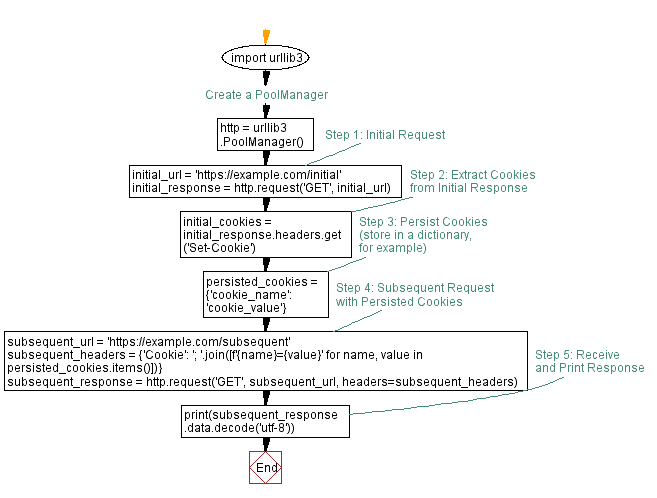Python urllib3: Demonstrate Cookie persistence for seamless Web requests
Write a Python program that sends and receives cookies with urllib3, demonstrating cookie persistence.
Sample Solution:
Python Code :
import urllib3
# Create a PoolManager
http = urllib3.PoolManager()
# Step 1: Initial Request
initial_url = 'https://example.com/initial'
initial_response = http.request('GET', initial_url)
# Step 2: Extract Cookies from Initial Response
initial_cookies = initial_response.headers.get('Set-Cookie')
# Step 3: Persist Cookies (store in a dictionary, for example)
persisted_cookies = {'cookie_name': 'cookie_value'}
# Step 4: Subsequent Request with Persisted Cookies
subsequent_url = 'https://example.com/subsequent'
subsequent_headers = {'Cookie': '; '.join([f'{name}={value}' for name, value in persisted_cookies.items()])}
subsequent_response = http.request('GET', subsequent_url, headers=subsequent_headers)
# Step 5: Receive and Print Response
print(subsequent_response.data.decode('utf-8'))
Sample Output:
<!doctype html>
<html>
<head>
<title>Example Domain</title>
<meta charset="utf-8" />
<meta http-equiv="Content-type" content="text/html; charset=utf-8" />
<meta name="viewport" content="width=device-width, initial-scale=1" />
<style type="text/css">
body {
background-color: #f0f0f2;
margin: 0;
padding: 0;
font-family: -apple-system, system-ui, BlinkMacSystemFont, "Segoe UI", "Open Sans", "Helvetica Neue", Helvetica, Arial, sans-serif;
}
div {
width: 600px;
margin: 5em auto;
padding: 2em;
background-color: #fdfdff;
border-radius: 0.5em;
box-shadow: 2px 3px 7px 2px rgba(0,0,0,0.02);
}
a:link, a:visited {
color: #38488f;
text-decoration: none;
}
@media (max-width: 700px) {
div {
margin: 0 auto;
width: auto;
}
}
</style>
</head>
<body>
<div>
<h1>Example Domain</h1>
<p>This domain is for use in illustrative examples in documents. You may use this
domain in literature without prior coordination or asking for permission.</p>
<p><a href="https://www.iana.org/domains/example">More information...</a></p>
</div>
</body>
</html>
Explanation:
Here's a brief explanation of the above Python urllib3 library code:
- Import the Necessary Modules:
- Import the "urllib3" module.
- Create a PoolManager Object:
- Create a "PoolManager" object to manage the connection pool for making HTTP requests.
- Send a Request with Cookies:
- Make an initial GET request to a URL and receive a response.
- Extract cookies from response headers.
- Persist Cookies:
- Store the received cookies in a data structure (e.g., a dictionary) for persistence.
- Send a Subsequent Request with Persisted Cookies:
- Make another request to the same or another URL, including the persisted cookies in the request headers.
- Receive and Print the Response:
- Receive the response and print the content to verify successful communication with persisted cookies.
Flowchart:

Python Code Editor :
Have another way to solve this solution? Contribute your code (and comments) through Disqus.
Previous: Python file upload with urllib3: Making POST Requests simplified.
Next: Python File Upload: Simulate POST request with multipart/Form-Data.
What is the difficulty level of this exercise?
Test your Programming skills with w3resource's quiz.
